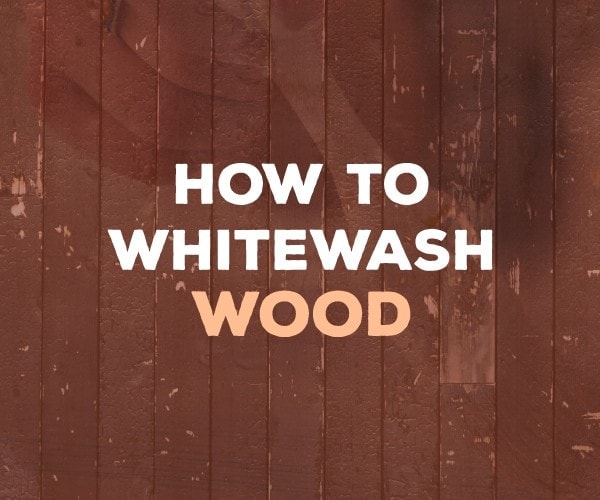Whitewashing wood is a great way to create a beautiful, weathered look on any home project. While it may look like it’s difficult and involved, getting a whitewashed finish is actually much easier than you may have thought.
Today, we’ll cover everything you need to know about how to whitewash wood, and by the time you’re finished with this guide, you should feel confident enough to tackle your own whitewashed project.
What You’ll Need
There are a few different ways that you can whitewash wood, and we’ll cover each of them in detail. The exact supplies you’ll use for each method differ slightly, but for the most part, all the supplies you need are the same. Here’s what you’ll need:
- White paint
- Water
- Mixing container
- Paint stirrer
- Clear or white candle
- Disposable gloves
- Saw horses or workbench
- Paintbrush
- Wide spackle knife
- Clean rags
Method I: Paint & Water
This is one of the easiest and most popular ways of how to whitewash wood. This method works best on new lumber with a smooth surface. If you’re working with older or reclaimed wood, you may want to try one of the other methods below instead.
First, you’ll need to mix your paint to the proper consistency. Depending on the look you’re going for, you’ll want to use more or less water to dilute the paint. As a rule of thumb, a 1:1 ratio is a great starting point.
Pour your paint and water into your mixing container, and mix it thoroughly with a paint stirrer.
Next, lay your project wood out, either on saw horses (for larger projects) or a workbench (for smaller ones.)
Dip a clean rag into your paint and water mixture, and apply it liberally to the surface of the wood. When you dilute paint, it behaves more like a stain, so keep that in mind when applying the mixture to the surface of the wood.
Depending on how opaque you want your finished product to be, you may want to apply another coat or two of your paint mixture.
Once you’re finished, allow 24 hours for the paint to completely dry. Once dry, you may want to consider using a sander along edges and in strategic spots throughout the piece to make the finish appear even more weathered.
Method II: Paint & Wax
This method creates a distressed and weathered look that looks especially authentic. If you didn’t know any better, you might assume that this finish was created from years of exposure.
The paint and wax method is ideal for all types of wood, whether it’s reclaimed or just purchased from the store. If you’re looking to create a heavily weathered look, this method is worth considering.
First, you’ll want to prepare the surface by rubbing a candle over specific areas of the wood. Use the side of the candle, and apply varying pressure as you move over the surface. The key here is to apply the wax randomly; thicker in some spots, thinner in others.
As you apply the wax, keep in mind that the waxed portion of the wood is the area that’s going to show the distressing. Depending on how distressed you want the final product to appear, you can apply more or less wax to the wood.
Next, use a paintbrush to paint the entire surface of the wood white. Allow the paint to partially dry, until the finish is lightly tacky (about 15-20 minutes.)
Now, take a clean rag and rub it over the surface of the wood. Applying heavier pressure will remove more paint from the surface. If you’re looking to create a heavily distressed finish, use a damp rag instead of a dry one for this step.
From there, just allow the finish to dry for 24 hours before use.
Method III: Drag Method
The drag method provides an interesting finish that really shines on reclaimed wood and any wood with a highly textured grain. You’ll want to steer clear of this method if you’re working with new wood. But, if you’re working with old, weathered wood, this finish may be perfect for your project.
First, you’ll want to dump a bit of paint directly onto the surface of the wood. I like to think of the paint as salad dressing, with the wood being my salad. Doing this gives me a feel for about how much paint I need on the wood, and keeps me from getting carried away and dumping too much paint onto the surface.
Next, take a wide spackle knife and spread the paint over the surface of the wood. If possible, try and do this with one broad stroke. At this point, your spackle knife should be covered in paint, and you can use this extra paint to fill in any areas on the wood that didn’t get quite enough color on them.
Final Word
Once your project has dried, you may want to consider applying a poly clear coat to protect the underlying finish. Or, leave the wood as is and let nature do it’s part to continue to age the finish.
Learning how to whitewash wood is a great way to add a beautiful vintage finish to virtually any woodworking project. While it may seem intimidating at first, it’s actually quite easy to create a beautiful whitewashed finish at home. Follow the tips above, and you’ll be a whitewashing pro in no time!

